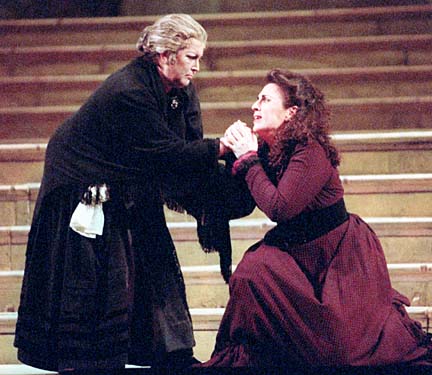Advertisement - Click to support our sponsors.


Cavalleria gets
the edge over
Pagliacci"Cavalleria Rusticana" and "Pagliacci": Presented by Hawaii Opera Theatre, 7:30 p.m. tomorrow and Thursday, Blaisdell Concert Hall. Tickets, $25 to $80. Call 596-7858.
By Ruth O. Bingham MASCAGNI'S Cavalleria Rusticana (Rustic Chivalry) and Leoncavallo's Pagliacci (Clowns), presented by Hawaii Opera Theatre in the traditional double billing, seem a perfect pair.
Special to the Star-BulletinThey share much, including similar settings (Sicily and Calabria), sequential times (dawn in Cavalleria, dusk in Pagliacci), and the juxtaposition of base human emotions played out during a holy day. Even their structures match, from their opening prologue arias through central intermezzi to abrupt, brutal endings.
What they do not share is tone and pacing. Cavalleria travels in one long, asymmetrical arch that, however short, allows the audience to wallow leisurely in each emotional moment. Pagliacci, on the other hand, moves in sharp angles so that, although almost exactly the same length by the clock, it seems to whiz by.
Not surprisingly, Pagliacci appeals more readily to modern audiences, as it did Friday night, but Cavalleria seduces more over the long run.
Cav/Pag, as the double bill is sometimes nicknamed, requires a small but stellar cast and offers the advantage of seeing singers in different roles on the same night.
Tenor Jean-Francis Monvoisin (Turiddu in Cav) and Canio in Pag), noticeably French in tone quality and diction, proved himself a vivid actor. He has a solid core to his voice, but his overly wide vibrato tended to swing out of control on held notes, and his lavish use of portamento lent an unnerving swooping effect.
Bass/baritone Mark S. Doss (Alfio in Cav), Tonio in Pag) created a formidable presence on stage, with a dark and virile voice to match. He seemed more comfortable with his role in Pagliacci, perhaps in part because the tessitura is lower. With clear diction and excellent acting, Doss shone throughout, especially in his rage aria in Cav, and in the prologue to Pag.
The female leads, written for different voice types were not doubled. Mezzo-soprano Sharon Graham (Santuzza) commanded Cavalleria vocally and dramatically. In a cast of large voices, hers was huge, with resonant lows, soaring highs, and shimmering pianissimos. Graham delivered one terrific moment after another. In fact, it was her climactic reading of "... and I loved him ..." that explained first and most clearly her intimacy with Turiddu. In a role that can be distasteful (the begging -- ugh), Graham created a very moving character.
Graham's was a tough act to follow, but Karen Driscoll (Nedda in Pag) excelled as well, with a ringing, flexible soprano and fiery acting. Driscoll handled Nedda's contradictions beautifully and shone as much in her ensembles as in her famous "birds" aria.
Effective comprimario roles contributed much. Sarah-Helen Land (Cherubino in HOT's Figaro) made a delightful Lola in Cav), her lighter, more open mezzo offering telling competition to Graham's darker timbre. Bea Lemke-Frieszell (a mezzo in the contralto role of Mama Lucia in Cav), portrayed a character delineated more through mime than voice and did so admirably.
Baritone David Templeton (Silvio in Pag), slender, handsome, and with a pleasant voice, rendered a believable lover, and in a light, clear tenor, Doug Jomes (Beppe in Pag), sang a charming serenade.
In short, director Michael Cavanagh had an excellent cast to work with and his staging of individuals and small ensembles built on that quality: the commedia, the scenes between Alfio and Turiddu, between Tonio and Nedda, bringing Tonio out from under the curtain to deliver his prologue -- all captivating.
That quality did not always carry through, however. Cavanagh's staging of the chorus disappointed: why spend the first 15 minutes of a short opera with no one on stage singing and with those on stage moving counter to the staging described in the music? Why waste the lovely vespers chorus on a static clump of singers? Why not use the intermezzo in Pagliacci? Why ask the stage audience not to react to murder?
Cavanagh also slipped occasionally on those oh-so-tiny, but oh-so-significant details (as in having an actress enter church to change for a performance) but overall, both works entertained successfully: Cavanagh's conception brought the stories alive, and his staging nimbly navigated a set constrained by stairs and large pieces.
The rented set presented an impossibly vast town square, with claustrophobically large, realistic buildings up front and sketched houses on a flat in back. Its most appealing aspect was a stretch of sky, which lighting designer Peter Dean Beck used creatively to echo mood and passing time.
Conductor Andreas Mitisek, who extended his stay after Figaro to fill in for a cancellation, managed the ample orchestra well, but allowed them too much rein in climaxes, when they overwhelmed even these large voices. Mitisek seemed to work well with the leads, but struggled with the chorus, which suffered from left-right phasing and in ensemble with the orchestra.
One last note: finally, an audible off-stage scream! But when it was repeated on stage, it really needed to be sung: screaming like that is not only painful to hear, but will soon shred the singer's voice.
Click for online
calendars and events.